All of following statements concerning the bacterial cell wall are true with the exception of
A. gives shape and rigidity to the cell
B. is the site of action for some antibiotics
C. prevents the cell from bursting in a hypotonic environment
D. cannot prevent a cell from undergoing plasmolysis when placed in a hypertonic environment
E. is the source of endotoxins in gram positive bacteria correct
E
The mechanism whereby genes are transferred by viruses (phages) from one bacterium to another
A. transduction
B. transformation
C. binary fission
D. intuition
E. conjugation
A
For each statement, select the best answer
A. uses light energy to drive the synthesis of organic compounds from CO2
B. uses CO2 to oxidize H2, releasing CH4 as a waste product
C. poisoned by O2
D. thrive in very hot environments
A. photoautotroph
B. methanogens
C. obligate anaerobe
D. extreme thermophile
Which of the following descriptions of protists is incorrect?
Protists are prokaryotic
When sunlight is unavailable, these protists can switch from an autotrophic nutritional mode to a heterotrophic one
Mixotrophs
A ___ is a reproductive structure of fungi that develops from a mycelium.
Fruiting body
Which of the following phyla produce uniflagellated zoospores?
A. Ascomycota
B. Basidomycota
C. Chytridomycota
D. Glomeromycota
E. Zygomycota
C
A graduate student finds an organism in a pond and thinks it is a freshwater sponge. A postdoc thinks it looks more like an aquatic fungus. How can they decide whether it is an animal or a fungus?
A. Figure out whether it is autotrophic or heterotrophic.
B. See if it reproduces sexually.
C. Determine whether it is unicellular or multicellular.
D. Look for cell walls under a microscope
E. See if it is a eukaryote or prokaryote.
D
Bilateral symmetry is associated with ____ development, localization of sensory structures in a distinct head region.
Cephalization
Which of the following combinations of phylum and description is incorrect?
A. Echinodermata - bilateral symmetry as a larva, coelom present
B. Cnidaria - radial symmetry, polyp and medusa body forms
C. Platyhelminthes - flatworms, gastrovascular cavity, acoelomate
D. Porifera - gastrovascular cavity, coelom present
E. Nematoda - roundworms, pseudocoelomate
D
Corals are most closely related to which group?
A. comb jellies
B. barnacles
C. sea anomones
D. sponges
E. bivalves
C
Which of the following phyla do not have blind-sac body plans (a gastrovascular cavity with a single opening)?
A. Annelida (polychaete worms, earth worms, leeches)
B. Platyhelminthes (flatworms)
C. Ctenophora (comb jellies)
D. Cnidaria (anemones, hydroids, corals, jellyfish, etc)
E. All of the above have blind-sac body plans
A
Which of the following is not an advantage of the arthropod exoskeleton?
A. provides protection from predators
B. provides rigid places for muscles to insert and against which they can do work
C. enhances sensory perception
D. prevents water loss
E. all of the above are an advantage of an exoskeleton
C
Which of the following is not a characteristic feature of the Chordata?
A. a bony skeleton of calcium phosphate
B. dorsal, hollow nerve chord
C. pharyngeal slits or clefts
D. a notochord
E. a muscular post-anal tail
A
What is a distinctive feature of the chondrichthyans?
A. a cartilaginous endoskeleton
B. an amniotic egg
C. lack of jaws
D. unpaired fins
E. an acute sense of vision that includes the ability to distinguish colors
A
How are primates different from all other mammals?
A. placental embryonic development
B. ability to produce milk
C. opposable thumbs in many species
D. hairy bodies
E. arboreal lifestyles
C
Jams, jellies, preserves, honey, and other foodstuffs with high sugar content hardly ever become contaminated by bacteria. This is because bacteria that encounter such an environment
A. are unable to swim through these thick and viscous materials
B. undergo death by lysis
C. are unable to metabolize the glucose or fructose, and thus starve to death
D. are obligate anaerobes
E. undergo death by plasmolysis
E
All of following statements concerning the bacterial cell wall are true with the exception of
A. prevents the cell from bursting in a hypotonic environment
B. prevents the cell from undergoing plasmolysis in a hypertonic environment
C. is the site of action for some antibiotics
D. gives shape and rigidity to the cell
E. is associated with some symptoms of disease
B
Which prokaryotes should be expected to be most strongly resistant to plasmolysis in hypertonic environments?
A. methanogens
B. extreme halophiles
C. cyanobacteria
D. extreme thermophiles
E. nitrogen-fixing bacteria that live in root nodules
B
The fact that prokaryotic ribosomes differ from eukaryotic ribosomes explains why
A. Prokaryotes are able to use a much greater variety of molecules as sources of food
B. Eukaryotes did not evolve from prokaryotes
C. Some antibiotics can block the insertion of peptidoglycan into the cell walls of bacteria
D. Some antibiotics can block protein synthesis of bacteria without affecting protein synthesis in the eukaryotic host
E. DNA synthesis occurs at a decreased rate in prokaryotes
D
An individual mixotroph loses its plastids (i.e. chloroplasts), yet continues to survive. Which of the following most likely accounts for its continued survival?
A. It relies on photosystems that float freely in its cytosol.
B. It must have gained extra mitochondria when it lost its plastids.
C. It has an endospore.
D. It engulfs organic material by phagocytosis or by absorption.
E. It is protected by a cell wall.
D
Which of the following is an example of symbiotic mutualism?
A. two paramecia exchanging genetic material
B. the diplomonad Giardia reproducing in a human intestine
C. the parabasalid T.vaginalis feeding on the vaginal lining of its human host
D. a zooflagellate digesting food in a termite’s intestine
E. none of the above
D
Of the following diseases, which are caused by a kinetoplastid?
1. Chagas Disease
2. Malaria
3. African Sleeping Sickness
4. Leishmaniasis
5. Trichinosis
A. 1, 2 and 3
B. 1, 3, and 4
C. 1 and 2
D. 2, 4 and 5
E. 3 and 4
B
Which of these statements concerning dinoflagellates is false?
A. Many are mixotrophs.
B. Toxins produced by certain dinoflagellates have caused massive kills of invertebrates and fishes.
C. They possess two flagella.
D. Some cause red tides.
E. Their dead cells accumulate on the seafloor and are mined to serve as a filtering material.
E
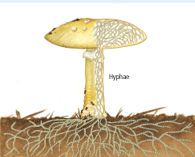
The underground portion of this fungus
A. releases spores
B. absorbs nutrients through the fruiting body
C. absorbs nutrients through the mycelium
D. allows for asexual reproduction
E. all of the above
C
What is the primary role of a mushroom's underground mycelium?
A. anchoring
B. absorbing nutrients
C. protection
D. asexual reproduction
E. sexual reproduction
B
The number of sets of chromosomes in a dikaryotic cell
A. is greater than in a diploid cell
B. is less than in a diploid cell
C. is equal to that in a diploid cell
D. none of these
C
The sac fungi or ___ is named for the ascus, a reproductive structure that contains spores.
Ascomycota
How are the vascular plants that are involved in mycorrhizae and the photosynthetic cells that are involved in lichens alike?
A. They are in intimate association with chytrids.
B. They secrete acids that keep the fungal partner from growing too quickly.
C. They produce zygosporangia.
D. They provide organic nutrients to fungal partners.
E. They are digested by fungal enzymes while still alive.
D
A researcher is trying to construct a molecular-based phylogeny of the entire animal kingdom. Assuming that none of the following genes is absolutely conserved, which of the following would be the best choice on which to base the phylogeny?
A. genes involved in chitin synthesis
B. collagen genes
C. genes involved in eye-lens synthesis
D. genes that cause radial body symmetry
E. genes involved in peptidylglycan synthesis
B
The probable sequence in which the following animal clades originated (from earliest to latest)?
1. radiata
2. coelomates
3. deuterostomia
4. parazoa
5. bilateria
A. 4, 5, 2, 1, 3
B. 5, 3, 4, 2, 1
C. 4, 1, 5, 2, 3
D. 1, 4, 5, 2, 3
E. 1, 3, 2, 4, 5
C
Which of the following functions is an advantage of a fluid-filled body cavity?
A. Internal organs are cushioned and protected from injury.
B. Organs can grow and move independently of the outer body wall.
C. The fluid within the cavitycan serve as a hydrostatic skeleton.
D. A and C only
E. A, B, and C
E
You are trying to identify an organism. It is an animal, but it does
not have nerve or muscle tissue. It is neither diploblastic nor
triploblastic. It is probably a(n) ___
.
Sponge
Which of the following combinations of phylum and description is incorrect?
A. Arthropoda-closed circulatory system, lophophore
B. Nematoda-pseudocoelomate, ecdysis
C. Porifera-no true tissues, choanocytes
D. Cinidaria-radial symmetry, diploblastic
E. Echinodermata-branch of bilateria, water vascular system
A
Which characteristic is shared by both cnidarians and flatworms?
A. dorsoventrally flattened bodies
B. flame cells
C. radial symmetry
D. a digestive system with a single opening
E. both A and D
D
Which of the following is true about flatworms?
A. They have a fluid-filled body cavity called a coelom.
B. They are the simplest animals to have three embryonic germ layers.
C. They are pseudocoelomates.
D. They are radially symmetric.
E. none of the above
B
A species of aquatic invertebrate is discovered anchored by a stalk
to its substrate. In addition to the stalk, the animal also has two
shells of calcium carbonate and a horseshoe-shaped crown of ciliated
tentacles that surround the mouth, which obviously functions as a
filter-feeding device. As an informed Bio 109 student you would
predict that this animal is a(n) ___
.
Brachiopod
While snorkeling, a student observes an active marine animal that has a series of muscular tentacles bearing suckers associated with its head. Segmentation is not observed, but a pair of large, well-developed eyes is evident. The student is observing an animal belonging to which class?
A. Apoda
B. Polyplacophora
C. Polychaeta
D. Bivalvia
E. Cephalopoda
E
All of the following can be observed in the phylum Annelida except
A. a gastrovascular cavity with a single opening
B. a well-developed coelom
C. a closed circulatory system
D. a ventral nerve cord
E. segmentation
A
The heartworms that can accumulate within the heart of dogs and other mammals have a pseudocoelom, an alimentary canal, and an outer covering that is occasionally shed. To which phylum does the heartworm belong?
A. Arthropoda
B. Nematoda
C. Annelida
D. Platyhelminthes
E. PhoronidaFeedback
B
On an expedition to the Amazon rain forest, you and a friend from another university happen upon an animal crawling through the leaf litter. The animal exhibits the following characteristics: worm-like segmented body, single pair of antennae, jaw-like mandibles and a large number of walking legs with one pair per segment. Your friend reaches down to pick it up; you immediately grab his arm realizing that this animal is most likely armed with ___
Poison claws
A post-anal tail and pharyngeal slits are characteristic of the phylum
A. Cephalopoda
B. Cnidaria
C. Echinodermata
D. Chordata
E. none of the above
D
Which of the following statements about vertebrates is (are) true?
A. The development of an amniotic egg and internal fertilization allowed vertebrates to produce away from water.
B. Birds are the extant vertebrates that are most closely related to to the dinosaurs.
C. All members of the phylum Chordata are vertebrates.
D. Reptiles were the first vertebrates to walk on land.
E. both A and B are true
E
What should be true concerning fossils of the earliest tetrapods?
A. They should indicate limited adaptation to life on land. correct
B. They should feature the earliest indications of the appearance of jaws.
C. They should show evidence of internal fertilization.
D. They should be transitional forms with the fossils of chondrichthyans.
E. They should show evidence of having produced shelled eggs.
A
What is the probable sequence in which the following clades of animals originated, from earliest to most recent?
1. tetrapods
2. vertebrates
3. deuterostomes
4. amniotes
5. bilaterians
A. 5 → 3 → 4 → 2 → 1
B. 3 → 5 → 2 → 1 → 4
C. 3 → 5 → 4 → 2 → 1
D. 5 → 3 → 2 → 1 → 4
E. 5 → 3 → 2 → 4 → 1
B
Why is the discovery of the fossil Archaeopteryx significant? It supports the
A. hypothesis that some extinct reptiles were endothermic.
B. contention that birds are much older than we originally thought.
C. claim that mammals and dinosaurs coexisted.
D. phylogenetic relatedness of birds and reptiles.
E. idea that the first birds were ratites.
D
The adaptive radiation of ___ following the Cretaceous extinctions filled niches vacated by the dinosaurs.
mammals
As humans diverged from other primates, which of the following appeared first?
A. an enlarged brain
B. bipedal locomotion
C. making of stone tools
D. language
E. the development of technology
B
Prokaryotes are much simpler in structure than eukaryotes, yet they have been extremely successful. Part of their success arises from mechanisms that enhance genetic diversity in prokaryotic populations. Describe two such mechanisms.
Rapid mutation rate due to their small size, reproduction by binary fission and short generation times. This leads to a tremendous amount of genetic diversity, which is the raw material that natural selection acts upon. Additional mechanisms that can lead to enhanced diversity arise from mechanisms that transfer genetic material between individuals: transformation, transduction and conjugation.
If a non pathogenic bacterium were to acquire antibiotic resistance, could this represent a significant health risk to human populations? Explain
Yes, the gene for antibiotic resistance could be transferred by transformation, transduction or conjugation to a pathogenic strain, making the pathogenic strain an even greater health risk to human populations. The converse of this is also acceptable, the transfer of pathogenic genes by horizontal gene transfer to the non-pathogenic bacterium.
Root hairs are important to a plant because they
A. increase the surface area for absorption
B. provide a habitat for nitrogen-fixing bacteria
C. anchor a plant in the soil
D. store starches
E. contain xylem tissue
A
Primary growth in plants is produced by the ___
Apical meristems
Active transport involves all of the following except
A. transport of solute against a concentration gradient
B. specific transport proteins in the membrane
C. diffusion of solute through the lipid bilayer of a membrane
D. hydrolysis of ATP
E. pumping of solutes across the membraneFeedback
C
What is the main force by which most of the water within xylem vessels moves toward the top of a tree?
A. atmospheric pressure on roots
B. the force of root pressure
C. evaporation of water through stoma
D. osmosis in the root
E. active transport of ions into the stele
C
Which one of the following pairs of plant structures has a haploid number (1n) of chromosomes?
A. Egg cell and antipodal cells
B. Megaspore mother cell and antipodal cells
C. Microspore mother cell and generative cell
D. Tube cell and generative cell
E. both A and D
E
Which of the following is not a mechanism utilized by plants to discourage self-fertilization?
A. brightly colored bracts that replace petals
B. formation of dioecious plants (plants having male and female reproductive organs in separate individuals)
C. self-incompatibility
D.stamen and carpels that mature at different times
E. anther and stigma structurally arranged to prevent pollen transfer in the same flower
A
One of the functions of gibberellins is to
A. signal the seed to break dormancy and germinate
B. promote fruit ripening
C. inhibit seed germination
D. retard leaf abscission
E. cause potassium channels in the plasma membrane of guard cells to open
A
You are preparing seeds for shipment abroad. The trip may take several weeks. To ensure that the seeds do not germinate prematurely you might consider treating them with
A. auxin
B. cytokinins
C. abscisic acid
D. ethylene
E. CO2
C
Where would you expect to find the littoral zone of a lake?
A. bottom region where organisms tend to attach themselves to one spot
B. deepest known, where light typically does not penetrate effectively
C. open water area farther from shore with enough sunlight for photosynthesis
D. shallow water area along the shore
E. near the thermocline
D
Which of the following are important biotic factors that can affect the structure and organization of biological communities?
A. light intensity, seasonality
B. precipitation, wind
C. temperature, water
D. availability of minerals, soil pH
E. predation, competition
E
A population is correctly defined as having which of the following characteristics?
I. inhabiting the same general area
II. individuals belonging to the same species
III. possessing a constant and uniform density and dispersion
A. I only
B. III only
C. I and II only
D. I, II, and III
C
Demography is the study of
A. death and emigration rates of a population at any moment in time
B. the vital statistics of populations and how they change over time
C. reproductive rates of a population during a given year
D. the survival patterns of a population
E. life expectancy of individuals within a population
B
It is generally stated that only about ___% of the energy available at one trophic level is incorporated into the tissues of animals at the next level.
10
The relationship between ___ and aerobic cellular respiration should be kept in mind when discussing the carbon cycle.
Photosynthesis
Which of the following causes an increase in the intensity of UV radiation reaching the Earth?
A. greenhouse effect incorrect
B. eutrophication
C. biological magnification
D. turnover
E. depletion of atmospheric ozone
E
A person working with plants may remove apical dominance by doing which of the following ___
Pruning
Starting from the tip of a developing root in a typical angiosperm to the above-ground stem, in what order would you expect to find the following?
1 Zone of elongation
2 Root cap
3 Zone of maturation (differentiation)
4 Zone of cell division
2,4,1,3
Based on the ABC model, what would be the structure of a flower that had normal expression of genes C and B but lacked expression of gene A?
carpel-stamen-stamen-carpel
A molecule in a plant is transported by staying within the cell wall and extracellular space. This molecule has taken which transport route?
A. transmembrane
B. apoplastic
C. protoplastic
D. iconoplastic
E. Symplastic
B
The value for Ψ in root tissue was found to be -0.25 MPa. If you take the root tissue and place it in a 0.1 M solution of sucrose (Ψ = -0.23), net water flow would
A. be from the sucrose solution into the tissue
B. occur only as ATP was hydrolyzed in the tissue
C. be from the tissue into the sucrose solution
D. be in both directions and the concentrations would remain equal
E. be impossible to determine from the values given here
A
Which of the following is not part of the transpiration-cohesion-tension mechanism for the ascent of xylem sap?
A. active pumping of water into the xylem of roots
B. hydrophilic walls of tracheids and vessels that help maintain the column of water against gravity
C. transfer of transpirational pull from one water molecule to the next, owing to cohesion by hydrogen bonds
D. lowering of ψ in the surface film of mesophyll cells due to transpiration
E. loss of water from the mesophyll cells, which initiates a pull of water molecules from neighboring cells
A
In plant roots, the Casparian strip is correctly described by which of the following?
A. It provides increased surface area for the absorption of mineral nutrients.
B. It ensures that all minerals are absorbed from the soil in equal amounts.
C. It provides energy for the active transport of minerals into the stele from the cortex.
D. It is located in the walls between epidermal cells and cells of the cortex.
E. It ensures that all water and dissolved substances must pass through a cell membrane before entering the stele.
E
Under which conditions will stomata generally be “open” to allow transpiration to occur?
1 at night
2 when guard cells are turgid (full of water)
3 when guard cells have low amounts of potassium ions inside them
2 only
Arrange the following five events in an order that explains the mass flow of materials in the phloem.
1. Water diffuses into the sieve tubes.
2. Leaf cells produce sugar by photosynthesis.
3. Solutes are actively transported into sieve tubes.
4. Sugar is transported from cell to cell in the leaf.
5. Sugar moves down the stem.
2,4,3,1,5
Pollination occurs when ______ .
A. pollen from the anther is transferred to the style of the ovary
B. pollen from the anther is transferred to the stigma of the carpel
C. pollen from the stigma is transferred to the anther of the ovary
D. sperm in the pollen tube combines with the polar nuclei in the ovule
E. sperm in the pollen tube combines with the egg in the ovule
B
How many mitotic divisions are required for conversion of the microspore to the male gametophyte?
One
Which of the following types of plant cells are haploid (1n)?
1 sporophyte main body
2 mega or microspore mother cell
3 gametophyte main body
4 gamete
5 zygote
3,4
Which of the following statements about reproduction in flowering plants is correct?
A. The female gametophyte consists of two haploid nuclei, one of which is the egg.
B. The generative cell undergoes one round of mitosis to form two sperm cells.
C. The pollen grain contains two cells, a sperm cell and a generative cell.
D. One sperm cell within the pollen tube will migrate to and unite with the antipodal cells, producing a triploid endosperm.
E. One sperm cell within the pollen tube will migrate to and fertilize the synergids, forming a zygote.Feedback
B
In the etiolation response, the main function of cGMP and Ca+2, aside from transferring the signal from cytoplasmic receptors to protein kinases in the cytosol, is to
A. amplify the signal from the cytoplasmic receptors (phytochrome)
B. inhibit enzymes of the de-etiolation response
C. enhance the sensitivity of phytochrome to light
D. increase the post-translational modification of existing proteins
E. transform light energy into chemical energy within the plant’s cytoplasm
A
A coleoptile is grown with unidirectional light coming from the left. If a transparent cap is placed on the tip of the growing plant, what will happen to the coleoptile?
A. It will turn different colors based on what day of the week it happens to be
B. It will grow taller and be straight up and down
C. It will grow taller and bend to the right
D. It will grow taller and bend to the left
E. It will stop growing taller
D
An eccentric botanist has offered a $25,000 scholarship to anyone who can successfully get a plant to grow through a vertical maze in complete darkness. The maze is not in a box; the maze is simply drawn on the wall, and the contestants must get their plant to grow in a pattern that matches the path through the maze. You need the money and feel confident that you can accomplish this task. Which of the following techniques will help you succeed?
A. Apply auxin to the side you want the shoot to bend and then immediately follow that with an application of abscisic acid.
B. Inject compounds that block auxin receptors into the part of the stem opposite from the direction you want the stem to bend.
C. Apply auxin directly to the part of the stem just below the tip opposite from the direction you want the stem to bend.
D. Plant the roots in two different pots, and apply auxin to the root bucket that is on the same side as the direction you want the plant to bend.
E. Apply auxin directly to the shoot tip on the side to which you want the tip to bend.
C
Which of the following plant hormones is not a growth promoter?
A. gibberellins
B. auxins
C. cytokinins
D. brassinosteroids
E. abscisic acid
E
Which of the following might be an investigation of microclimate?
A. competitive interactions between various species of songbirds during spring migration
B. the effect of ambient temperature on the onset of caribou migration
C. the seasonal population fluctuation of nurse sharks in coral reef communities
D. the effect of sunlight intensity on species composition in a decaying rat carcass correct
E. the effect of different nitrogen applications on corn productivity
D
Which of the following events might you predict to occur if the tilt of Earth's axis relative to its plane of orbit was increased beyond 23.5 degrees?
A. Summers in the United States might become warmer.
B. Winters in Australia might become more severe.
C. Seasonal variation at the equator might decrease.
D. A, B, and C are correct.
E. Only A and B are correct.
E
Which of the following statements about light in aquatic environments is correct?
A. Most photosynthetic organisms avoid the surface where the light is not too intense.
B. Photosynthetic organisms that live in deep water probably use red light.
C. Water selectively reflects and absorbs certain wavelengths of light.
D. Longer wavelengths penetrate to greater depths.
E. Light penetration seldom limits the distribution of photosynthetic species.
C
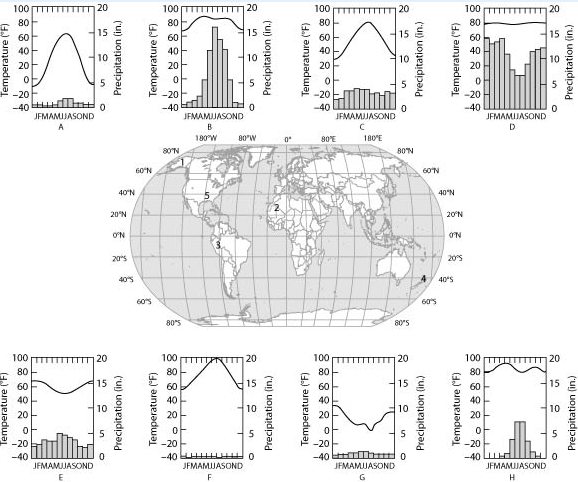
The eight climographs below show yearly temperature (line graph and left vertical axis) and precipitation (bar graph and right vertical axis) averages for each month for some locations on Earth. Choose the climograph that best answers the question.
1. Which climograph shows the climate for location 1?
2. Which climograph shows the climate for location 2?
3. Which climograph shows the climate for location 3?
1. A
2. F
3. D
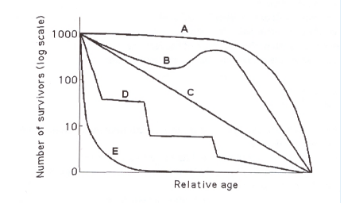
Which curve above best reflects survivorship in marine mollusks?
E
If during the year there are 75 births in a population of 300 individuals, what is the annual per capita birth rate?
.25
In the logistic equation dN/dt = rN , r is a measure of the population's intrinsic rate of increase. It is determined by which of the following?
A. carrying capacity
B. dispersion
C. density
D. life history
E. birth rate and death rates
E
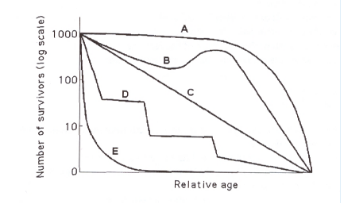
Organisms whose life history adaptation is called iteroparity would most likely display which of the following survivorship curves?
A
What type of population would be associated with a population pyramid that had an extremely broad base?
A. a stable population
B. a rapidly expanding population
C. a population where the birth rate equaled the death rate
D. a population with more males than females
E. a population where there were more old individuals than young individuals
B
Which of the following is true about secondary consumers in an ecosystem?
A. They are smaller and weaker than are primary consumers.
B. They are eaten by primary consumers.
C. They eat only plants.
D. They contain the greatest total biomass in the system.
E. They are fewer in number than are primary consumers.
E
What is the fundamental difference between matter and energy?
A. Matter can be converted into energy; energy cannot be converted into matter.
B. Matter is used in ecosystems; energy is not
C. Energy is cycled through ecosystems; matter is not.
D. Energy can be converted into matter; matter cannot be converted into energy.
E. Matter is cycled through ecosystems; energy is not.
E
Which of the following best explains why there are seldom more than five trophic levels in a food chain?
A. Most carnivores function at more than one trophic level.
B. Top carnivores are too few in number to prey effectively.
C. Energy is lost from each trophic level.
D. The ecosystem contains too much biomass.
E. Trophic levels above this number contain too many individuals.
C
The energy diagram for a grasshopper reveals the following: For every 300 J of plant material consumed, 100 J end up in the feces, 150 J is used up during cellular respiration and 50 J is incorporated into new biomass. What is the production efficiency of the grasshopper?
A. 17%
B. 50%
C. 40%
D. 25%
E. 33%
D
In the nitrogen cycle, the transformation of gaseous nitrogen into nitrogen-containing compounds is performed primarily by ___
prokaryotes
This causes extremely high levels of toxic chemicals in fish-eating birds.
A. eutrophication
B. acid precipitation
C. greenhouse effect
D. depletion of ozone layer
E. biological magnification
E
Describe two features of an angiosperm (anatomical or physiological) that are adaptations to the stresses imposed by a terrestrial environment.
1) stomata
(2) waxy cuticle
(3) vascular tissue
(4) roots, tap root system
(5) water storage leaves as in some desert plants
(6) C4 plants or crassulacean acid metabolism
(7) fruit, seeds
(8) double fertilization
(9) chemical defenses
(10) flowers to attract pollinators
(11) ethylene triple response
Describe the mechanism (at a molecular level) that plants utilize to open and close their stomata. What plant hormone, produced during a period of water deficiency, can induce stomatal closing? (Limit your response to 4 sentences.)
Proton pumps are activated in guard cells creating a negative membrane potential. This negative potential facilitates the movement of K+ ions into the cell causing a decreased water potential inside the cell. Water flows into the cell causing the guard cell to expand and change shape, opening the stomata. Abscisic acid produced in the roots induces the guard cells to close.
Consider two rivers: One is spring fed and has a constant water volume and temperature year-round; the other drains a desert landscape and floods and dries out at unpredictable intervals. Which river would you predict is more likely to support many species of semelparous animals? Why?
The river that drains the desert landscape. In an environment that is more unstable or unpredictable, the smaller, more numerous offspring produced by semelparous species, have a greater chance of survival.
The four principal types of tissues are
A. epithelial, skeletal, connective, reticular
B. epithelial, connective, muscle, nervous
C. blood, bone, nervous, epithelial
D. connective, skeletal, epithelial, nervous
E. muscle, nervous, skeletal, connective
B
Which of the following would not be considered a thermoregulatory adaptation in mammals or birds?
A. vasodilation of peripheral blood vessels
B. increased heat production (thermogenesis)
C. insulation
D. endothermy
E. countercurrent heat exchange
D
Which of the following would increase the rate of heat exchange between an animal and its environment?
A. feather or fur
B. vasoconstriction
C. blubber or fat layer
D. wind blowing across the body surface
E. all of the above
E
Vitamins are classified based on
A. whether they affect carbohydrates or proteins
B. how much they are required
C. the amount of energy they contain
D. whether they are water or fat soluble
E. none of the choices are correct
D
During this stage of food processing, food is broken down into molecules small enough for the body to absorb ___
Digestion
This flap of cartilage prevents food from entering the trachea ___
Epiglottis
What are the only vertebrates in which blood flows directly from respiratory organs to body tissues without first returning to the heart?
Fishes
These autorhythmic cells located in the wall of the right atrium control the rate and timing at which all cardiac muscle cells contract
Sinoatrial (SA) node
During exhalation in humans, air moves from the bronchus into the ___
Trachea
Which is not a part of the innate immune system of vertebrates?
B cells
What is the function of helper T-cells?
A. the production of soluble antibodies
B. initiation of inflammation
C. promotion of B-cell and T-cell activity
D. phagocytosis of bacteria and viruses
E. production of specific antibodies against pathogens
C
Allergies are the result of an exaggerated immune response. What triggers this response?
Allergens
If two solutions that differ in their osmolarity are separated by a selectively permeable membrane (permeable to water only), the net flow of water is
A. equal in both directions
B. from the hyperosmotic to the hypoosmotic solution
C. from hypoosmotic to hyperosmotic solution
D. from the solution containing less free water to the solution containing more free water
E. both C and D
C
Ammonia _____.
A. is the major nitrogenous waste excreted by insects
B. is soluble in water
C. is metabolically more expensive to synthesize than urea
D. is the major nitrogenous waste product excreted by humans and birds
E. has low toxicity relative to urea
B
Which of the following is not a step common to most excretory systems that produce urine?
Ingestion
Of the following choices, the epithelium with the shortest diffusion distance is _____.
A. pseudostratified ciliated columnar epithelium
B. simple squamous epithelium
C. stratified squamous epithelium
D. simple cuboidal
E.simple columnar epithelium
B
Homeostatic mechanisms
A. help to keep a relatively constant internal environment in the body
B. usually operate by positive feedback
C. act to keep values out of the normal range
D. produce most disease conditions
E. keep variables exactly at the set point
A
You discover a new species of bacteria that grows in aquatic environments with high salt levels. While studying these bacteria, you note that their internal environment is similar to the salt concentrations in their surroundings. You also discover that the internal salt concentrations of the bacteria change as the salt concentration in their environment changes. The new species can tolerate small changes in this way, but dies from large changes because it has no mechanism for altering its own internal salt levels. What type of homeostatic mechanism is this species using to regulate its internal salt levels?
Conformation
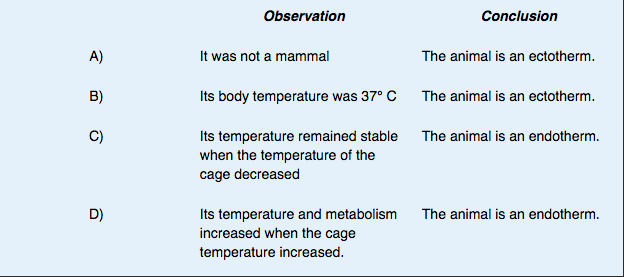
Four students carried out studies to determine whether a newly discovered animal was an ectotherm or endotherm. Each student made one observation and one conclusion. Which is the correct conclusion based on the observation?
C
An example of an ectothermic organism that has few or no behavioral options when it comes to its ability to adjust its body temperature is a _____
sea star living deep in the ocean
The metabolic rate of a fasting, non-stressed ectotherm at rest at a specific temperature
SMR
A researcher is setting up an experiment to measure basal metabolic rate in prairie voles (Microtus ochrogaster–a small rodent). Which of the following would be the best set of conditions for the voles immediately before and during the measurement?
A. House the animals in a cage with plenty of food and water to avoid stress; conduct measurements in a warmer room than the room where housed.
B. House the animals in a cage with no food for a few hours before measurement; conduct measurements in a colder room than the room where housed, and exercise the voles.
C. House the animals in a cage with plenty of food and water to avoid stress; conduct measurements in a room the same temperature as the room where housed.
D. House the animals in a cage with no food for a few hours before measurement; conduct measurements in a room the same temperature as the room where housed.
D
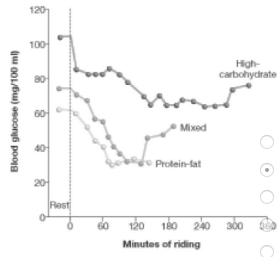
Three groups of cyclists consumed three different types of diets: high-carbohydrate; a diet mixed in carbohydrates, fat, and protein; or a diet higher in protein and fat. The average time each group could spend cycling over a six-hour period is shown in the above graph. What conclusion from the data would help an athlete or trainer improve performance?
A. Diet is not at all related to endurance.
B. Endurance is entirely related to diet.
C. A mixed diet increases long-term endurance.
D. Maintaining elevated blood sugar improves performance.
E. An early 50 percent drop in blood glucose is associated with improved endurance.
D
Compare an animal with a gastrovascular cavity to an animal with a tube-type digestive system. What is/are the major advantage(s) of having a tube?
A. It allows the animal to consume a second meal while the first is being digested.
B. It permits development of specialized enzymes and concentration of digestive juices in different regions.
C. It permits more time for enzymatic action.
D. Additional physical cutting and grinding of the food bolus is made possible.
E. All of the above choices are advantages
E
The liver produces bile which functions to
A. protect the stomach and small intestine from HCl
B. help emulsify or break down fats for digestion
C. enhance absorption of proteins and carbohydrates
D. initiate the breakdown of proteins
E. all of the above
B
In the stomach, HCl in gastric juice ______
A. kills bacteria
B. breaks down the connective tissue of muscle
C. activates pepsin
D. all of the above
E. none of the above
D
How does the digestion and absorption of fat differ from that of carbohydrates?
A. Carbohydrates need to be emulsified before they can be digested; fats do not.
B. Fat absorption occurs in the stomach; carbohydrates are absorbed by the small intestine.
C. Processing of fats does not require any digestive enzymes; processing of carbohydrates does.
D. Fat must be worked on by bacteria in the large intestine before it can be absorbed; carbohydrates do not.
E. Most absorbed fat first enters the lymphatic system; carbohydrates directly enter the blood.
E
Which of the following statements concerning type II diabetes is TRUE?
A. This form of diabetes usually appears during childhood.
B. This form of diabetes results from the destruction of pancreatic beta cells by the immune system.
C. Excess body weight and lack of exercise increase the risk of developing the disease.
D. Fewer than 10% of people with diabetes have type II
E. All of the above are true statements.
C
Which of the following statements concerning an open circulatory system is true?
A. the circulatory fluid does not require respiratory pigments for O2 transport
B. the lower pressures provide for more effective delivery of O2 than is possible with a closed system
C. the circulatory fluid is also the interstitial fluid
D. it has higher hydrostatic pressure and is less energy efficient than a closed system
E. a heart is not required to pump the circulatory fluid through the circulatory vessels
C
Calculate the heart rate of an individual with a cardiac output of 10 L/min and a stroke volume of 100 mL.
100 beats/min
If the atrioventricular node (AV node) were surgically removed from the heart without disrupting signal transmission to the Purkinje fibers,
A. only the venticles would contract
B. atria and ventricles would contract at about the same time
C. no apparent effect on heart activity would be observed
D. only the atria would contract
E. the heart rate would decrease
B
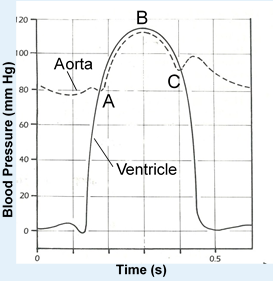
The graph above shows the pressure changes in the left ventricle and aorta during a single heartbeat. The abrupt changes of pressure in the aorta at points A and C are most likely caused by the
A. spread of excitation from the SA to AV nodes
B. opening and closing of the AV valve
C. contraction of the atria
D. opening and closing of the semilunar valve
E. elastic recoil of the pulmonary vein
D
The expansion of the lung and inhalation of air are, in part, the result of
A. the muscles of the lungs relaxing, allowing the lungs to get larger
B. decreased pressure of the interpleural fluid
C. the contraction of the muscles of the diaphragm
D. All of the above are correct.
E. Only A and B are correct.
C
During inhalation
A. diaphragm and rib muscles remain stationary
B. diaphragm contracts and the rib muscles relax
C. diaphragm relaxes and rib muscles contract
D. diaphragm and rib muscles contract
E. diaphragm and rib muscles relax
D
A dry mixture of gases has a total pressure of 750 mm Hg, and oxygen comprises 20% of the gas mixture. The partial pressure of oxygen (PO2) is equal to ___
150 mm Hg
The immune system releases a molecule of _______ that causes the redness, heat, and swelling of the inflammatory response (as well as the itching, sneezing, and runny nose of an allergic reaction).
Histamine
Which of the following is not a property of the adaptive immune system?
A. immunological memory
B. lack of reactivity against host cells
C. receptor diversity
D. rapid rate of respons
E. every specific response to pathogens
D
Your body has millions of different antibodies for detecting millions of different antigens because
A. you have millions of different antibody genes
B. antibody genes undergo rearrangement
C. antibody genes undergo antigen shifting
D. all of the above
E. none of the above
B
When a B cell or T cell encounters an antigen for which it has an antigen receptor, the B or T cell will divide repeatedly to make copies of itself. This process is called ___
Clonal selection
B cells and T cells that do not immediately attack pathogens, but instead remain inactive until a future encounter with the pathogen, are referred to as ___
memory B and T cells
Why are measles vaccinations effective?
A. They cause the inflammation response resulting in the production of antibodies that engulf the measles virus if it enters the body.
B. They cause an immune response resulting in the production of cytotoxic (killer) T cells that remain in the blood attacking all viruses that enter the body.
C. They cause an immune response resulting in the production of memory B cells that provide a rapid response if the individual is subsequently infected by the measles virus.
D. They cause the inflammation response resulting in the production of memory T cells that provide a limited response if infected by the measles virus.
E. none of the above
C
The term _______ disease refers to any disease where the immune system attacks particular molecules of the individual’s own body (loss of self-tolerance).
Autoimmune
To maintain homeostasis freshwater fish must _____.
A. excrete large quantities of electrolytes
B. consume large quantities of water
C. excrete large quantities of water
D. take in electrolytes through simple diffusion
E. none of the above
C
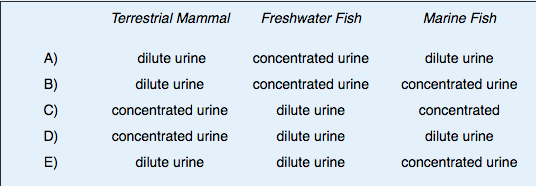
A biologist studied the concentration of urine produced by a terrestrial mammal, a freshwater fish and a marine fish. Which row of observations would be the most likely for these organisms in their natural environment?
C
Marine birds eliminate excess salts through their
A. kidneys
B. salt glands in their heads
C. general body surface (skin)
D. all of the above
E. none of the above
B
The more concentrated the urine that a mammal can produce, the longer are its
A. Bowman's capsules
B. proximal convoluted tubules
C. Malpighian tubules
D. glomeruli
E. loops of Henle
E
As filtrate moves down the loop of Henle, the surrounding interstitial fluid has a _____ osmolality than the filtrate, so _____ leave(s) the filtrate.
higher, water
ADH increases water reabsorption in the collecting ducts by
A. increasing the number of sodium ion channels in the proximal tubule
B.increasing the number of aquaporin channels in the ascending loop of Henle
C.increasing the number of aquaporin channels in the collecting ducts
D. all of the above
E. none of the above
C
The pancreas carries out both endocrine functions (long term activity, such as secreting hormones) and exocrine functions (short term activity, such as secreting enzymes). What are the major endocrine excretions of the pancreas? What is their role in maintaining glucose homeostasis?
The major endocrine secretions by the pancreas are the hormones insulin and glucagon. Insulin decreases blood glucose levels by increasing the uptake of glucose by most cells in the body and by increasing the conversion of glucose to glycogen by the liver. Glucagon increases blood glucose levels by promoting the breakdown of glycogen in the liver and the release of glucose into the blood.
Explain the mechanism by which the renin-angiotensin-aldosterone-system (RAAS) regulates blood volume and pressure. What type of feedback circuit is involved. Be sure to include all components of the feedback system in your answer.
A drop in blood volume or pressure (due to dehydration or blood loss) is detected by the JGA, which releases renin into the blood. Renin causes the conversion of angiotensinogen through a series of reactions to angiotensin II. Angiotensin II causes arterioles to constrict raising blood pressure. Angiotensin II also acts upon the adrenal gland causing the release of aldosterone. Aldosterone acts upon the distal tubules resulting in an increase in reabsorption of Na+ and water, which increases blood volume.
This type of secreted signalling molecule does not alter the physiology of the animal producing the molecule.
A. autocrine
B. synaptic
C. neuroendocrine
D. pheromone
E. paracrine
D
In this type of signaling, neurohormones diffuse into the bloodstreams and trigger responses in target cells anywhere in the body.
Neuroendocrine
A cell with membrane-bound proteins that selectively bind a specific hormone is called that hormone's _____.
target cell
Synthesized in the hypothalamus, these hormones travel along the extended axons of neurosecretory cells to the posterior pituitary.
ADH and oxytocin
A form of asexual reproduction in which the egg develops without being fertilized.
Parthenogenesis
Which of the following structures in females is analogous in function to the vas deferens in males?
A. vagina
B. oviduct
C. urethra
D. clitoris
E. uterus
B
The thick, yellowish and alkaline fluid produced by these accessory glands constitutes approximately 60% of the volume of semen.
Seminal vescicles
The primary function of the corpus luteum is to _____.
A. nourish and protect the egg cell
B. maintain progesterone and estrogen synthesis after ovulation has occurred
C. stimulate the development of the mammary glands
D. raise estrogen levels prior to ovulation
E. initiate ovulation
B
The movement of the membrane potential from a value of -70 mV to a value of -80 mV would be termed a(n) ___
Hyperpolarization
In a resting potential, an example of a cation that is more abundant as a solute in the cytosol of a neuron than it is in the interstitial fluid outside the neuron is _____.
A. Cl-
B. K+
C. Na+
D. Ca++
E. all of the above are equally abundant in the cytosol
B
The transmission of an action potential (AP) typically requires the cell membrane of this region of the neuron to reach threshold.
axon hillock
The point of connection between two communicating neurons is called the _____.
synapse
When two excitatory postsynaptic potentials (EPSPs) occur at a single synapse so rapidly in succession that the postsynaptic neuron's membrane potential has not returned to the resting potential before the second EPSP arrives, the EPSPs add together producing _____.
A. the refractory state
B. an IPSP
C. spatial summation
D. tetanus
E. temporal summation
E
Answer the following questions on glial cells.
1. myelinate axons in the CNS
2. produce the myelin sheaths that surround axons in the PNS
3. participate in formation of the blood-brain barrier
4. immune cells in the CNS that protect against pathogens
1. oligodendrocytes
2. Schwann cells
3. astrocytes
4. microglia
The divisions of the nervous system that have antagonistic or opposing actions are
A. motor and sensory
B. forebrain and hindbrain
C. presynaptic and postsynaptic
D. central nervous system and peripheral nervous system
E. sympathetic and parasympathetic
E
Which of the following coordinates muscle actions?
Cerebellum
What do Wernicke's and Broca's regions of the brain affect?
Speech
Different body cells can respond differently to the same peptide hormones because _____.
A. different target cells have different sets of genes
B. a target cell's response is determined by the components of its signal transduction pathways
C. the circulatory system regulates responses to hormones by routing the hormones to specific targets
D. the hormone is chemically altered in different ways as it travels through the circulatory system
E. none of the above
B
The different effect of the hormone epinephrine on the blood vessels of the intestines and skeletal muscle involve
A. different signal transduction pathways
B. varying levels of the hormone in the blood
C. different receptors for the hormone
D. all of the above
E. only A and C
E
Which of the following statements comparing water-soluble and lipid-soluble hormones is TRUE?
A. Only water-soluble hormones bind to a receptor protein to initiate their response.
B. Water-soluble hormones require the aid of a transport protein to reach their target tissue.
C. Both types of hormones can be transported in the blood stream to their target sites.
D. Only water-soluble hormones can alter the transcription of specific genes.
E. Both types of hormones initially bind to cell-surface receptors before entering the cytoplasm.
C
Which of the following hormones has a nontropic effect only?
Prolactin
Releasing and inhibiting hormones secreted by nerve cells of the ______________ regulate hormones released by the _____________.
Hypothalamus, anterior pituitary
Because the hormone ecdysone causes both molting and metamorphosis in the caterpillar to a butterfly, what determines when metamorphosis takes place?
A. rising levels of ecdysone
B. decreasing levels of ecdysone
C. high levels of juvenile hormone (JH)
D. low JH levels
E. both A and C
D
A disease that destroys the adrenal cortex should lead to an increase in the plasma levels of _____.
A. estradiol
B. epinephrine
C. acetylcholine
D. adrenocorticotropic hormone (ACTH)
E. glucocorticoid hormones
D
Sexual reproduction
A. allows animals to conserve resources and reproduce only during optimal conditions
B. can produce diverse phenotypes that may enhance survival of a population in a changing environment
C. guarantees that both parents will provide care for each offspring
D. enables males and females to remain isolated while rapidly colonizing habitats
E. yields more numerous offspring more rapidly than is possible with asexual reproduction
B
Which of the following statements comparing spermatogenesis and oogenesis is (are) TRUE?
A. Only in oogenesis do all four products of meiosis develop into mature gametes.
B. Oogenesis can produce mature eggs in a continuous sequence, whereas spermatogenesis has long interruptions.
C. Spermatogenesis, including the mitotic divisions of stem cells, occurs throughout adolescence and adulthood.
D. All of the above are true statements.
E. Both A and B are true statements.
C
Increasing the temperature of the human scrotum by 2°C (that is, near the normal body core temperature) and holding it there would most likely_____.
A. reduce the fertility of the man by impairing the production of gonadal steroid hormones
B. increase the fertility of the affected man by enhancing the rate of spermatogenesis
C. increase the fertility of the affected man by enhancing the rate of steroidogenesis
D. reduce the man's sexual interest
E. reduce the fertility of the man by impairing spermatogenesis
E
Which statement about human reproduction is correct?
A. Fertilization occurs in the uterus.
B. Formation of a mature oocyte requires fewer meiotic divisions than formation of a mature sperm cell.
C. A human oocyte completes meiosis after a sperm penetrates it.
D. The earliest stages of spermatogenesis occur closest to the lumen of the seminiferous tubules.
E. In humans, spermatogenesis and oogenesis function best at normal, core body temperatures.
C
All of the following are involved in hormonal control of the male reproductive system except:
progesterone
All of the following hormones are involved in the uterine cycle except:
prolactin
The level of this hormone coordinates the follicular phase of the ovarian cycle with the proliferative phase of the uterine cycle.
estradiol
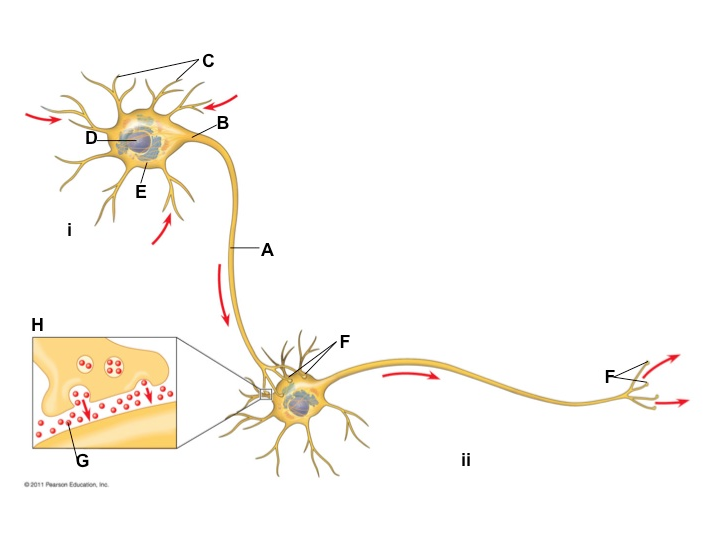
The diagram above depicts two neurons (i and ii ). The letter F (present in both cells) points to ___ while the letter E points to ___
the synaptic terminals, cell body
Action potentials move along axons
A. more rapidly in myelinated than in non-myelinated axons
B. by activating the sodium-potassium "pump" at each point along the axonal membrane
C. more slowly in axons of large diameter than of small diameter
D. by reversing the concentration gradients for sodium and potassium ions
E. by the direct action of acetylcholine on the axonal membrane
A
Which of the following hormones undergoes positive feedback during labor?
A. prolactin
B. FSH
C. oxytocin
D. estradiol
E. LH
C
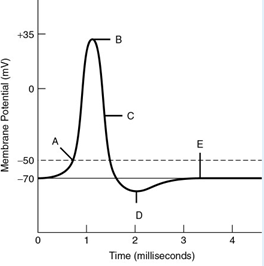
1. The membrane's permeability to sodium ions is at its maximum at label.
2. The cell is not hyperpolarized; however, repolarization is in progress, as the sodium channels are closing or closed, and many potassium channels have opened at label
3. The membrane potential is closest to the equilibrium potential for potassium at label.
4. The minimum graded depolarization needed to operate the voltage-gated sodium and potassium channels is indicated by the label.
1. B
2. C
3. D
4. A
The observation that the acetylcholine released into the junction between a motor neuron and a skeletal muscle binds to a sodium channel and opens it is an example of a ___
ligand-gated sodium channel
The adding together of EPSPs generated by a single presynaptic terminus is an example of ___
temporal summation
Assume that a single IPSP has a negative magnitude of - 0.5 mV at the axon hillock, and that a single EPSP has a positive magnitude of + 0.5 mV. For a neuron with initial membrane potential is -70 mV, the net effect of the simultaneous arrival of 6 IPSPs and 4 EPSPs would be to move the membrane potential to ___
-71 mV
Which of the following is a direct result of depolarizing the presynaptic membrane of an axon terminal?
A. Ligand-gated channels open, allowing neurotransmitters to enter the synaptic cleft.
B. Voltage-gated calcium channels in the membrane open.
C. The postsynaptic cell produces an action potential.
D. The postsynaptic cell membrane becomes hyperpolarized.
E. Synaptic vesicles fuse with the membrane.
B
Which of the following activities would be associated with the sympathetic division of the nervous system?
A. fight-or-flight response
B. decreased heart rate
C. increased glycogen production
D. rest and digestion
E. release of acetylcholine
A
The motor (efferent) part of the autonomic nervous system
A. has preganglionic neurons that release epinephrine
B. provides efferent innervation of skeletal muscle
C. functions in the control of smooth and cardiac muscle
D. contains only preganglionic fibers
E. contains only post ganglionic fibers
C
Which of the following structures or regions is INCORRECTLY paired with its function?
A. limbic system - generation and experience of emotion
B. medulla oblongata - control of skeletal muscle contraction
C. cerebellum - coordination of movement and balance
D. hypothalamus - regulation of temperature, hunger, and thirstcorpus
E. callosum - communication between the left and right cerebral cortices
B
The motor cortex is located in which part of the nervous system?
cerebrum
Which of the following describes the functional controls of Wernicke's area?
A. It coordinates the response to olfactory sensation
B. It is active during the generation of speech
C. It is found on the left side of the brain
D. It is active when speech is heard and comprehended
E. It coordinates the response to olfactory sensation
D
Individuals who have suffered a brain injury and cannot form any new lasting memories but can recall events that occurred before their injury have most likely suffered damage to their ___
hippocampus
The brain's white matter consists of
A. dendrites
B. unmyelinated axons
C. myelinated axons
D. ganglia
C
The left and right hemispheres of the brain are able to communicate with each other due to
A. basal nuclei
B. cerebrospinal fluid
C. cerebellum
D. corpus callosum
D
Describe the two ways in which neurotransmission is terminated, as well as where specifically they take place.
Neurotransmission can be terminated by enzymatic breakdown of the neurotransmitter in the synaptic cleft, or reuptake of the neurotransmitter by the presynaptic neuron.
Explain how EPSPs can produce temporal and spatial summation of an action potential in a post-synaptic neuron. Explain how an IPSP may cancel the effect of an EPSP. Be sure to mention whether a depolarization or hyperpolarization is involved in each scenario.
Temporal summation is when two or more EPSPs occur in rapid succession to overcome the threshold potential via depolarization, resulting in an action potential.
Spatial summation is when two or more EPSPs occur in close proximity to overcome the threshold potential via depolarization, resulting in an action potential.
If an IPSP’s hyperpolarization is equal to or greater than an EPSP’s depolarization, then the EPSP’s effect is canceled.